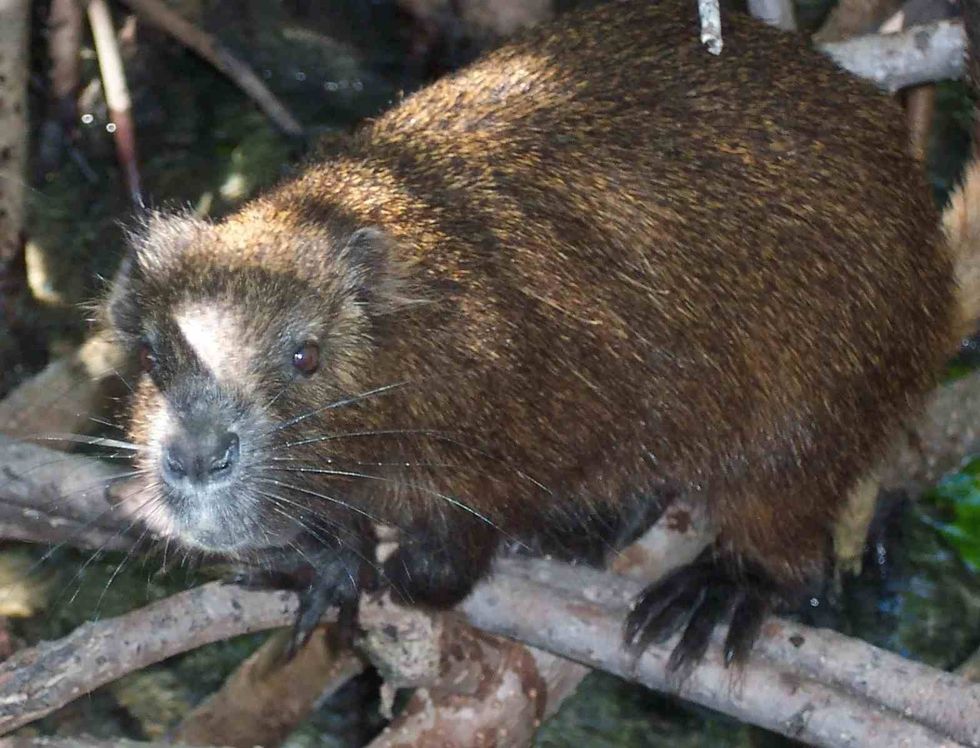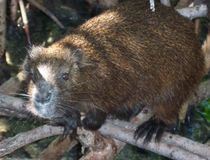An endemic species to the island of Hispaniola, the Hispaniolan hutia (Plagiodontia aedium) is the only confirmed extant species of the Plagiodontia genus. The species is sometimes found in Haiti and the Dominican Republic.
These mammals are generally bigger than several rodent species. The average weight and length of a Hispaniolan hutia are around 3 lb (1 kg) and 13.7–16 in (35-41 cm), respectively. The species possesses dense brown or gray fur, while its underparts are buff in color.
The tail is generally scaly and has no fur. The Hispaniolan hutia has five digits on both its barefoot and hindfoot. Also, a female hutia has three pairs of thoracic mammae.
Hispaniolan hutias are nocturnal and arboreal, and they generally spend lots of time on trees, unlike other terrestrial mammals. They dwell in tree cavities, while some populations also inhabit burrows. Roughy hillsides and ravines of 6561.68 ft (2000 m) elevation from sea level also serve as their habitat.
The IUCN has listed these mammals as Endangered. Apart from the Hispaniolan hutia, some other species of the genus Plagiodontia are extinct. This threatened species is majorly affected by habitat destruction, hunting, and invasive species such as mongeese, cats, dogs, and many more.
Keep on reading to learn more interesting facts about the Hispaniolan hutia. If you want to know more exciting information about different animals, check out the gerbil and the marsupial mole too.
Hispaniolan Hutia Interesting Facts
What type of animal is a Hispaniolan hutia?
The Hispaniolan hutia (scientific name: Plagiodontia aedium) is a native species to Haiti and the Dominican Republic. The population of this threatened species is declining in the wild. Unlike other terrestrial animals, the species spends most of its time on trees.
What class of animal does a Hispaniolan hutia belong to?
The Hispaniolan hutia belongs to the class of Mammalia, the family of Capromyidae, and the genus Plagiodontia.
How many Hispaniolan hutias are there in the world?
The exact population of this threatened species is not known as of now, but it is declining constantly. The habitat of these hutias is often sadly cleared for agricultural activities. If their numbers keep falling continuously, the species might become extinct in the upcoming decades.
Where does a Hispaniolan hutia live?
The Hispaniolan hutia is endemic to the Dominican Republic and Haiti, both countries fall in the Caribbean region.
What is a Hispaniolan hutia's habitat?
Like other members of the Capromyidae family, the Hispaniolan hutia is nocturnal and arboreal. The animal generally spends lots of time on trees, unlike other terrestrial mammals.
This hutia mainly dwells in tree cavities while some populations also use burrows to inhabit. Roughy hillsides and ravines of 6562 ft (2000 m) elevation from sea level can also serve as a Hispaniolan hutia habitat.
Who do Hispaniolan hutias live with?
Very little information regarding the social behavior of the Hispaniolan hutia is available as of now, but the species generally lives in pairs. A pair includes one male and one female who come together during the breeding season.
How long does a Hispaniolan hutia live?
The Hispaniolan hutia can easily live up to 15.9 years if kept in captivity. One of the most major threats to this threatened species in the wild is habitat and ecology obstruction.
How do they reproduce?
Very little is known about the reproduction patterns of the Hispaniolan hutia species. Females generally go through an estrous cycle of around 10 days and are receptive to mating with males during this period.
The gestation period generally lasts for around 120-150 days and either one or two offspring are born in each breeding season. Unlike other rodents, a young hutia is generally more mature from the moment of birth.
What is their conservation status?
The IUCN has listed these mammals as Endangered. Apart from the Hispaniolan hutia, some other species of the genus Plagiodontia are extinct. This threatened species is majorly affected by habitat destruction, hunting, and invasive species such as mongeese, cats, dogs, and many more. Human encroachment is also emerging as a threat to these animals.
Hispaniolan Hutia Fun Facts
What do Hispaniolan hutias look like?
This species possesses dense brown or gray fur, while its underparts are buff in color. Its tail is generally scaly and it has no fur. The Hispaniolan hutia has five digits on both its barefoot and hindfoot. Also, a female hutia has three pairs of thoracic mammae. Their unusual teeth help to identify the species.

*Please note that this is an image of Desmarest's hutia, not Hispaniolan hutia. If you have an image of Hispaniolan hutia, please let us know at hello@kidadl.com.
How cute are they?
The Hispaniolan hutia is one of the most fascinating species of the Dominican Republic. Unlike most species of the Capromyidae family, young huitas are more mature from the moment of birth. We need to protect these little cuties as they are the only extant species of the Plagiodontia genus.
How do they communicate?
Like other species of the Capromyidae family, these mammals follow similar methods of communication. They possess soft and bird-like chirps that are used to find their mates and indicate danger. They are quite social members of the animal kingdom and generally live by forming pairs.
How big is a Hispaniolan hutia?
The average weight and length of a Hispaniolan hutia are around 3 lb (1 kg) and 13.7–16 in (35-41 cm), respectively. The mammal is three times the size of the jerboa and the shrew.
How fast can a Hispaniolan hutia run?
The exact speed of the species is not known, but the hutia is very active during the night.
How much does a Hispaniolan hutia weigh?
The average weight of a Hispaniolan hutia is around 3 lb (1 kg).
What are their male and female names of the species?
There are no specific names given to male and female hutias, people generally refer to them as Hispaniolan hutias. Unlike males, females possess three pairs of thoracic mammae.
What would you call a baby Hispaniolan hutia?
No particular names have been given to a baby Hispaniolan hutia, but terms such as pups are often used to refer to the babies of rats.
What do they eat?
This mammal is a herbivore and the average Hispaniolan hutia diet generally includes roots, tubers, leaves, stems, and bark. Some other hutia species such as Desmarest's hutia are carnivores and prey on small vertebrates and invertebrates. The Hispaniolan hutia is often preyed upon by mongeese and oncillas.
Are they poisonous?
No, these animals are not poisonous but they can attack if someone tries to provoke or threaten them. They also possess oblique teeth. It is always advised not to provoke or harm these vulnerable members of the animal kingdom.
Would they make a good pet?
It is illegal to keep Hispaniolan hutias as pets as the population of the species is declining constantly. They have a worrying conservation status and several organizations have made conservation plans to protect them.
Did you know...
The Hispaniolan solenodon (Solenodon paradoxus) is said to be another extant animal endemic to Hispaniola island.
Are Hispaniolan hutias endangered?
Yes, the IUCN has listed the species' conservation status as Endangered. This threatened species is majorly affected by habitat destruction, hunting, and invasive species such as mongeese, cats, dogs, and many more. Human encroachment is emerging as a threat to these animals too. This human encroachment is often done in the name of agricultural development.
How did the Hispaniolan hutia get its name?
The genus name Plagiodontia is derived from two ancient Greek words, 'plagios' and 'odous'. The meaning of the terms are 'placed sideways' and 'tooth', respectively. Their oblique teeth are the most unique feature of this species.
Here at Kidadl, we have carefully created lots of interesting family-friendly animal facts for everyone to discover! Learn more about some other mammals from our nutria facts and gopher facts pages.
You can even occupy yourself at home by coloring in one of our free printable hispaniolan hutia coloring pages.
*Please note that this is an image of Desmarest's hutia, not Hispaniolan hutia. If you have an image of Hispaniolan hutia, please let us know at hello@kidadl.com.










